Description

Disclaimer: Copyright infringement not intended.
Context: The Supreme Court on Wednesday banned all construction activities in the core areas of tiger reserves, national parks and wildlife sanctuaries after it was brought to its notice by a court-appointed panel that illegal constructions for establishment of a tiger safari was being done within in the buffer area of the Corbett Tiger Reserve in Uttarakhand.
Details:
- A bench sought response from the Centre and the NTCA on the recommendation of SC-appointed central empowered committee (CEC) to review guidelines for setting up of zoos and safaris within tiger reserves and wildlife sanctuaries in India in order to discourage tourism in wildlife habitat
- “The MoEF&CC to review norms issued under Forest (Conservation) Act, 1980 and Wildlife (Protection) Act, 1972 relating to setting up of zoos and safaris within tiger reserves and wildlife sanctuaries and amend the same so as to discourage use of wildlife habitat for wildlife tourism activities which are non site specific. Any approvals given for setting up of zoos and safaris within tiger reserves and protected areas are withdrawn forthwith...” CEC said.
.jpeg)
Tiger:
- Tiger (Panthera tigris) is the largest living cat species.
- It is an apex predator.
- Tiger cubs stay with their mother for about two years and then become independent, leaving their mother's home range to establish their own.
- Since the early 20th century, tiger populations have declined by at least 93%.
- Major reasons for population decline are habitat destruction, habitat fragmentation and poaching.
- Tigers are also victims of human-wildlife conflict, particularly in range countries with a high human population density.
- Today, the tiger's range is fragmented, stretching from Siberian temperate forests to subtropical and tropical forests on the Indian subcontinent, Indo-china and Sumatra.
- The tiger is listed as Endangered on the IUCN Red List.
- The tiger is the national animal of India, Bangladesh, Malaysia and South Korea.
- Protected under schedule 1of Wildlife Protection Act.
- As of 2019, India’s Tiger population stands at a total of 2967 which is 70% of the global tiger population.
- India successfully fulfilled its target of doubling tiger numbers, made at St. Petersburg in 2010, much before the target year of 2022.
- The Indian states with the Tiger population:
- Madhya Pradesh – 526
- Karnataka – 524
- Uttrakhand – 442
- Maharashtra – 312
Tiger Reserves of India (as on December, 2022):
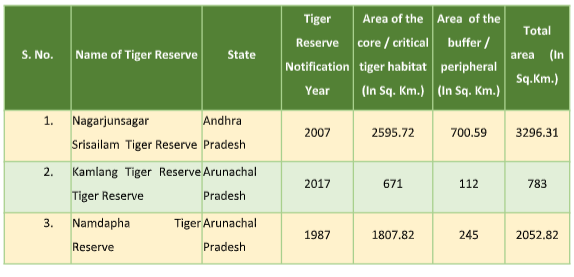
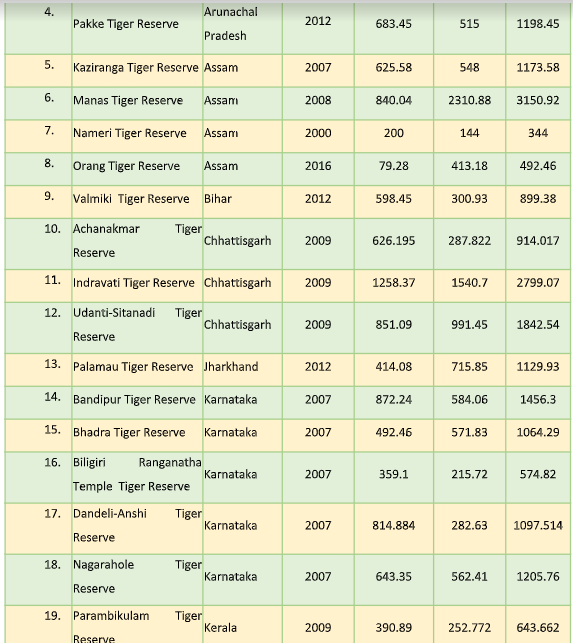

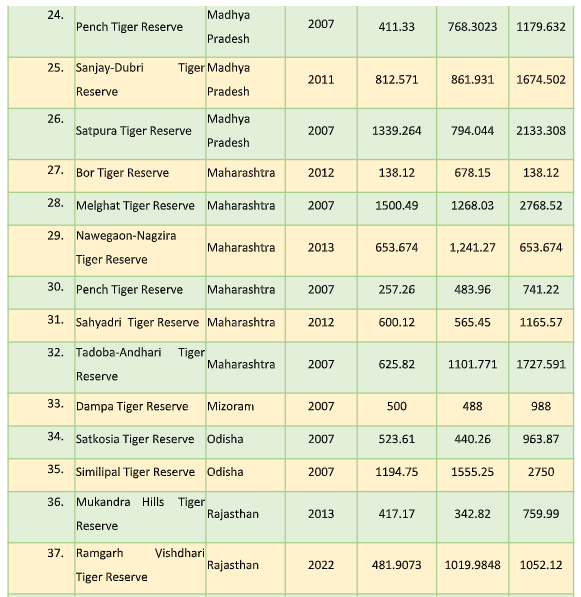
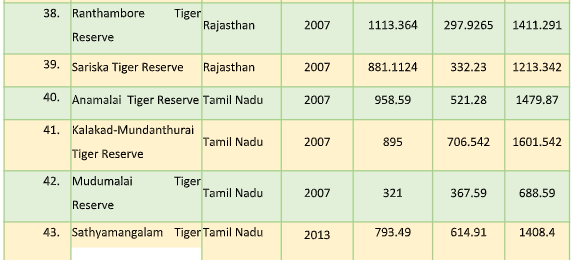
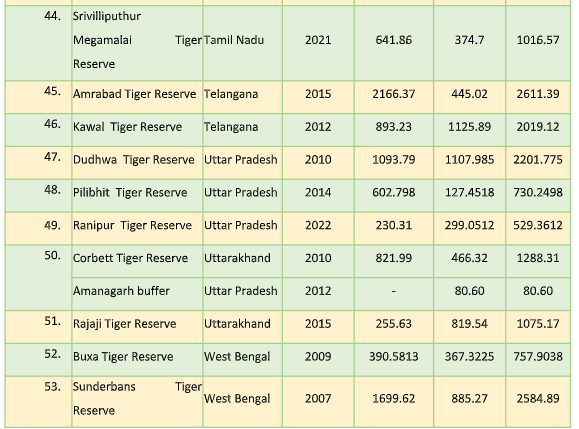
Tigers in India:
- India's strategy of tiger conservation attaches topmost importance to involving local communities.
- India is home to over 70% of the tiger population globally.
- India is home to 53 tiger reserves and the last tiger census of 2018 showed a rise in the tiger population.
- India achieved the target of doubling of tiger population four years ahead of schedule of the St. Petersburg Declaration on tiger conservation.
- National assessment for the “Status of Tigers, Co-predators, Prey and their Habitat” is conducted once in every four years. The methodology used for this assessment was approved by the Tiger Task Force in 2005. The first assessment based on this scientific methodology was done in 2006 and subsequently in 2010, 2014 and 2018.
- The fourth cycle of National tiger status assessment of 2018-19 is the most accurate survey conducted.
CA|TS:
- It is a conservation tool that sets minimum standards to manage target species, and encourages assessments to benchmark progress.
- Launched in 2013, the tool was developed in collaboration with field managers, tiger experts and government agencies engaged in tiger conservation.
- CA|TS is a partnership of tiger range governments, inter-governmental agencies, institutions, NGOs and conservation organisations.
Project Tiger:
- This tiger conservation programme launched in April 1973by the Government of India during Prime Minister Indira Gandhi's tenure.
- Aim: Ensuring a viable population of Bengal tigers in their natural habitats, protecting them from extinction, and preserving areas of biological importance as a natural heritage
- From 9 tiger reserves since its formative years, the Project Tiger coverage has increased to 50 at present, spread out in 18 of our tiger range states.
- The tiger reserves are constituted on a core/buffer strategy.
- Core areas are the legal status of a national park or a sanctuary.
- Whereas, buffer or peripheral areas are a mix of forest and non-forest land, managed as a multiple use area.
- The government has set up a Tiger Protection Force to combat poachers and funded relocation of villagers to minimize human-tiger conflicts.
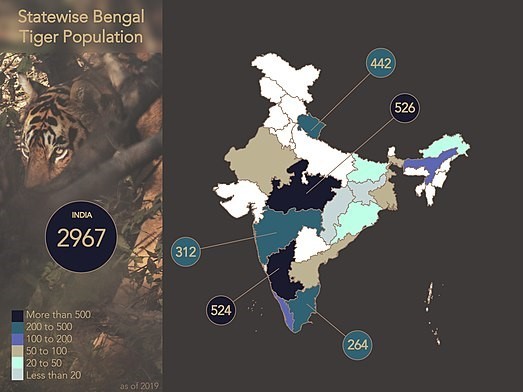
NTCA:
National Tiger Conservation Authority was established in 2005 following a recommendation of the Tiger Task Force, to reorganise management of Project Tiger and the many Tiger Reserves in India. It is the overarching body for conservation of tigers in India.
Structure of NTCA:
- Environment Minister is the Chairman of the NTCA.
- Below chairman are eight expertsor professionals having qualifications and experience in wildlife conservation and welfare of people including tribals, apart from three Members of Parliament (1 Rajya Sabha, 2 Lok Sabha).
- The Inspector General of Forests, in charge of project Tiger, serves as ex-officio Member Secretary.
Functions:
- Its main administrative function is to approve the Tiger Conservation Plan prepared by the State Governmentsand then evaluate and assess various aspects of sustainable ecology and disallow any ecologically unsustainable land use such as, mining, industry and other projects within the tiger reserves.
- As per the WLPA, every State Government has the authority to notify an area as a tiger reserve.
- However, the Tiger Conservation Plans sent by state government need to be approved by the NTCA first.
- Alternatively, Central Government via NTCA may advise the state governments to forward a proposal for creation of Tiger Reserves.
Other Functions of NTCA are as follows:
- Regulation and standardization of tourism activities
- Provide for management focus and measures for addressing conflicts of men and wild animals.
- Provide information on protection measures.
- Ensure that the tiger reserves and areas linking one protected area or tiger reserve with another protected area or tiger reserve are not diverted for ecologically unsustainable uses, except in public interest and with the approval of the National Board for Wild Life and on the advice of the Tiger Conservation Authority.
- Facilitate and support the tiger reserve management in the State.
- Ensure critical support including scientific, information technology and legal support for better implementation of the tiger conservation plan.
- TX2 stands for “Tigers times two”, signalling the goal to double the population of wild tigers by 2022.
- India and Bhutan are among 13 countries working towards TX2, a goal that the World Wildlife Fund(WWF) had set through the Global Tiger Initiative, Global Tiger Forum and other critical platforms.
- The number of the striped cat in the Indian Manas increased from nine in 2010 to 25 in 2018 while that in the Bhutan Manas more than doubled from 12 in 2008 to 26 in 2018.

Global Tiger Initiative (GTI):
- The Global Tiger Initiative (GTI) was launched in 2008 as a global alliance of governments, international organizations, civil society, the conservation and scientific communities and the private sector, with the aim of working together to save wild tigers from extinction.
- In 2013, the scope was broadened to include Snow Leopards.
- The GTI’s founding partners included the World Bank, the Global Environment Facility (GEF), the Smithsonian Institution, Save the Tiger Fund, and International Tiger Coalition (representing more than 40 non-government organizations).
- The initiative is led by the 13 tiger range countries (TRCs).
Global Tiger Forum:
- The Global Tiger Forum (GTF) is the only inter- governmental international body established with members from willing countries to embark on a global campaign to protect the Tiger.
- The GTF was formed in 1993 on recommendations from an international symposium on Tiger Conservation at New Delhi, India.
- The GTF is focused on saving the remaining 5 sub-species of Tigers distributed over 13 Tiger Range countries of the world.
TX2 Conservation Excellence Award:
- TX2 is the global award, which was set up in 2010 in St. Petersburg, Russia by international organizations working for tiger conservation like UNDP, Global Tiger Forum, International Union for Conservation of Nature, World Wide Fund for Nature, Conservation Assured/Tiger Standards and the Lion's Share.
- The TX2 awards include a financial grant to assist ongoing conservation.
- The award recognises a site that has achieved excellence in two or more of five themes:
- Tiger and prey population monitoring and research (tiger translocation/prey augmentation);
- effective site management;
- enhanced law enforcement,
- protection and ranger welfare improvement;
- community-based conservation,
- benefits and human-wildlife conflict mitigation and habitat and prey management.
- In 2018, the Pilibhit Tiger Reserve (PTR) in Uttar Pradesh also won the TX2 award for


https://timesofindia.indiatimes.com/india/no-construction-in-core-areas-of-tiger-reserves-national-parks-supreme-court/articleshow/97750462.cms





















